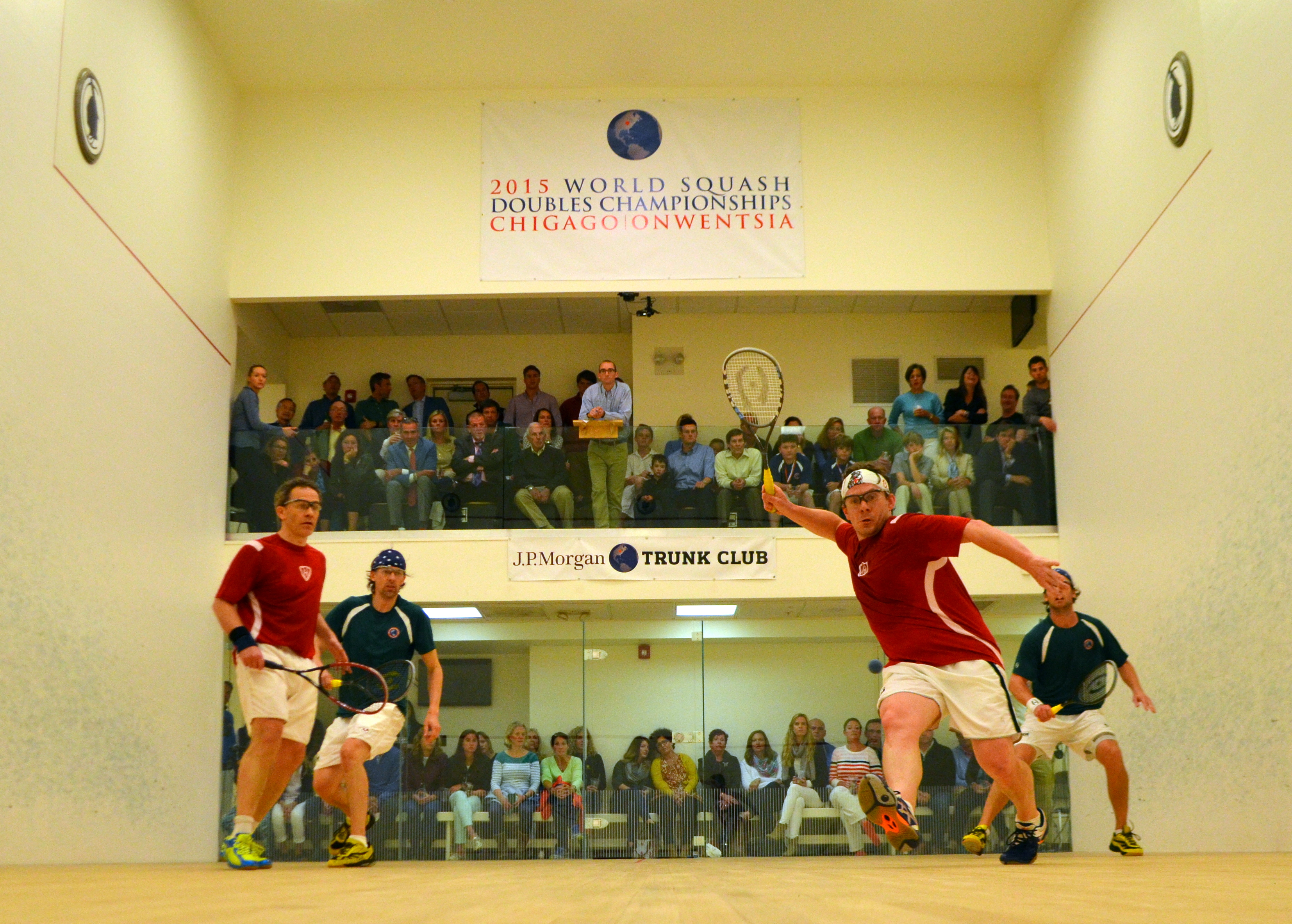
by Rob Dinerman
Dateline May 15th — When Clive Leach and John Russell defeated Damien Mudge and Ben Gould in five riveting games in early May in the final round of the 2015 World Doubles to clinch their third tournament win in six months, they thereby punctuated a terrific first season as partners, while simultaneously puncturing a Mudge/Gould winning streak that had grown to 27 matches (and seven tournaments) and pointing up the substantially changing nature of the competitive landscape atop the SDA men’s pro doubles tour. Their comeback victory from a two games to one deficit was an eyebrow-raising capstone to the 2014-15 campaign that complemented their prior wins at the Big Apple Open and the Tompkins Invitational, marking a return to the top-echelon level for Russell after several years of relative inactivity, and also constituting a unique longevity-proving achievement for Leach, who, amazingly, has now won more tournaments (seven) in the two and a half years since he turned 40 in mid-November 2012 than the total he amassed (six) in more than a decade on the pro-doubles tour prior to reaching this normally squash-success-dooming chronological milestone!
As well, this outcome put a definite damper on what was, statistically, a fifth straight dominant season for Mudge and Gould, whose numbers during their half-decade of partnership are truly compelling. They have recorded 49 tournament wins in 56 attempts over that span, including going nine for 12 — with wins in the Denver Club Invitational, the Maryland Club Open, the Jim Bentley Cup in Toronto, the Putnam Pro-Am Doubles in Boston, the North American Open in Greenwich, the David C. Johnson Jr. Memorial in Brooklyn, the Baltimore Cup, the Tavern Club Invitational in Cleveland and the Kellner Cup in New York — this past season, with a 36-3 match record. No other team has won more than four tournaments during that period, and at one juncture Mudge and Gould, who went wire-to-wire undefeated during their first season as teammates in 2010-11, won 46 straight matches and 14 consecutive tournaments.

But however admirable, indeed overwhelming, their tally over the years has been, it must be said as well that their few stumbles have been extremely costly and ill-timed, on both the practical and esthetic levels, coming as they have on some of the game’s biggest stages and for the most part in eerily similar and chastening fashion. They were unable to convert multiple-match-balls prior to the fifth game in both the 2011 and 2013 editions of the biennial Briggs Cup, whose $100,000 purse is by far the biggest on the tour, as well as in the final of the 2013 Boston event, and in all three cases they then lost the fifth game handily. This past year they were 0-2 in five-game matches, both losses coming against Russell/Leach, one of which occurred in New York in a Big Apple Open semi, the other happening, as noted, in the biennial World Doubles at the Onwentsia Club in suburban Chicago.
In both matches Mudge and Gould led two games to one after taking the third game 15-14, and in both cases after dropping the fourth game they fell too far behind in the fifth to catch up. Ironically the very degree to which Mudge and Gould obliterate their opponents most of the time seems to sometimes operate AGAINST them by leaving them less prepared to handle the exigencies of a pressure-packed moment on the rare occasions when they find themselves locked in a tight match against an elite team that has the courage and wherewithal to not back down when faced with their pace and athleticism. At crunch-time in the fifth game in Chicago, Mudge and Gould committed some damaging unforced errors and were unable to exploit the vulnerable state of a severely cramping Leach, who could barely stand up on his immobilized left leg but was still able to conjure up some reverse-corner winners at the end, including one at 14-11 that flat-footed Gould and brought an end to the 150-minute marathon.

Their one remaining setback this past season came in the final round of the PDC Cup in Atlanta at the hands of the tour’s No. 2 ranked pairing of Manek Mathur and his mid-2000’s Trinity College teammate Yvain Badan, whose fifth season as partners was also by far their most consistent, as signified by their 10 final-round advances (nine runner-up finishes, eight of them to Mudge/Gould, plus the Atlanta breakthrough) in 11 appearances, their sole pre-finals loss coming in a mid-January St. Louis semi against first-time partners Hamed Anvari and Viktor Berg, who then beat another first-year set of partners, namely Michael Ferreira and his former early-2000’s Trinity College teammate Jonny Smith, in the final. Anvari and Berg then went on to reach the semis of the North American Open and to capture the Challenger tournament in Germantown.
Though Ferreira and Smith went winless against the Big Three of Mudge/Gould, Mathur/Badan and Russell/Leach, they were frequent semifinalists throughout the season and also won the Challenger tournament in Virginia in decisive fashion. There were more sanctioned ranking tournament-winning teams (4); more finalists (six, including the Big Three, the two teams that contested the St. Louis final and Tompkins Invitational runners-up Bernardo Samper and Baset Chaudhry, yet another pair of Trinity College alums); and more semifinalists pairings (17) than at any time in the decade and a half that a formal pro doubles tour has existed, dating back to the formation of the International Squash Doubles Association in 2000, in what is clearly a marker of both how full the schedule and how deep and competitive the playing field have become.

Greg Park reached the semifinal stage a total of six times with four different partners, including with Imran Khan (three times) and at the World Doubles, where Park and Preston Quick, U. S. National Doubles champions in 2012 and 2013, defeated Ferreira and Smith in the quarters. Raj Nanda was a semifinalist with Park in St. Louis, with Fred Reid Jr. in Baltimore and with Leach in Cleveland. And Berg, a former ISDA No. 1 with Mudge from 2008-10 before a several-years hiatus from the pro circuit, returned in emphatic fashion this season, complementing his exploits as Anvari’s partner by attaining the semis with Jacques Swanepoel in Denver and with Reid at the World Doubles, where he also teamed up with Steph Hewitt to earn the Mixed Doubles crown by defeating Americans Quick and Natalie Grainger in the semis and Chris Callis and Amanda Sobhy in the final.
As mentioned, the 2014-15 season witnessed the successful emergence of several first-year partnerships consisting of longtime tour veterans who had never joined up on any extended basis prior to this past autumn (Russell/Leach, Ferreira/Smith and Berg/Anvari chief among them), but there were also some TRULY new teams composed of SDA rookies who made an immediate and significant impact. Of these by far the most noteworthy was the Toronto-based duo of Robin Clarke and Scott Arnold, friends from their mid-2000’s forays on the PSA singles tour, both 29 and teaching pros at prominent Toronto clubs (Clarke at Badminton & Racquet, Arnold at Cricket Skating & Curling) who, after entering the 2014 Canadian National Doubles, unseeded, unheralded and essentially on a lark, earned their way into the winner’s circle.

Deciding to give the SDA tour a try in the wake of that unexpected but decisive accomplishment, they then debuted with a third-place finish at the Jim Bentley Cup highlighted by wins over Willie Hosey and Mike Pirnak, Will Mariani and Jeff Lurie, Quick/Park and Gary Waite/Thomas Brinkman, following which they qualified into the main draw in Boston, won the Pittsburgh Golf Club Challenger with a final-round 3-0 tally over Carl Baglio and Andres Vargas, successfully defended their Canadian National Doubles title with a close four-game win over Mariani and Brinkman, out-played Khan and Park en route to the semis in Cleveland and did the same to Reid and Khan in the round-of-16 at the Kellner Cup.
This flurry of compressed and consistently successful activity on the part of this pair of rangy athletes, whose victories for the most part were forged by excellent court coverage, impressive pace and an extraordinary degree of freedom from the tin, was enough to land them just inside the SDA top ten by season’s end, marking them as a team on the clear ascent and likely auguring even better things for them in 2015-16 as their front-court capability increases and they learn their way around the league. The SDA tour currently features an intriguing mix of emerging challengers, rejuvenated and in several cases re-aligned contenders, natural alliances and established reigning title-holders, whose standing atop the sport by all odds figures to be put to greater duress than ever next season if recent trends continue. The tour has consistently grown in prize money, sites and membership from one year to the next, and next season might well be the best ever for professional doubles in North America.

